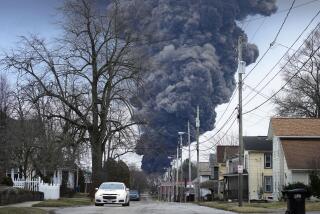Release of Lethal Fumes Is Uncertain, Experts Say
- Share via
There are so many ways to manufacture the deadly nerve gas VX that no one can say for certain whether dangerous chemical fumes were released into nearby civilian neighborhoods when U.S. Tomahawk cruise missiles leveled the Shifa Pharmaceutical plant in Khartoum, Sudan, several chemists said Thursday.
Some of the chemicals used to make VX--chlorine, for example--can be poisonous themselves. But almost all the methods used to make the gas primarily involve relatively harmless chemicals readily available at a pharmaceutical facility or scientific supply house, civilian experts in chemical weapons said.
The nerve gas itself is so powerful that small doses can cause blindness, hallucinations, convulsions and death--its vapors lingering on the ground for weeks before dispersing.
But because the plant was suspected of making only raw materials for the manufacture of the gas, not the nerve gas itself, some experts said it is unlikely that lethal fumes were released Thursday when the building was destroyed. There is also little likelihood of the long-term health hazards that afflicted U.S. troops after the destruction of Iraqi chemical weapons storage facilities during the 1991 Persian Gulf War, they said.
“In general, the compounds that are used as precursors are chemicals you would use in normal laboratory operations, and they would not have outstanding toxicity,” said Joseph Epstein, a consultant on the detection of chemical weapons who holds a patent on the production of the VX nerve gas. “Some of the precursors might be things that are on the open market.”
At least one terrorist group is known to have actively experimented with the use of VX as a weapon, said UCLA political science professor David C. Rapoport, editor of the quarterly academic journal “Terrorism and Political Violence.” But no group so far has been known to have used it in a terrorist attack.
“It has been expected that it would be one of the weapons used by terrorists,” Rapoport said. “It is supposed to be deadlier than sarin gas”--the nerve gas used by Japanese terrorists in a 1995 attack on Tokyo’s subway system.
As a weapon, VX also is easier to handle than sarin because it is not as volatile, the experts said. It can be inhaled, but it also can be absorbed almost instantly through the skin.
It was a key part of the U.S. Army’s chemical weapons arsenal for years, until such lethal agents were formally banned by international treaty.
(BEGIN TEXT OF INFOBOX / INFOGRAPHIC)
Nerve Agent VX
The Shifa Pharmaceutical plant bombed in Khartoum, Sudan, was being used to make “precursor chemicals that could be used for VX,” Defense Secretary William S. Cohen said Thursday. A few drops of VX, the most deadly nerve agent produced today, can kill a person in minutes. Colorless and odorless, it works by interfering with signals sent from the brain to vital organs of the body.
****
EFFECTS ON BODY:
* Increased perspiration
* Cough
* Acute oxygen deprivation
* Gastrointestinal distress
* Effects on skeletal musculature
* Death by suffocation; the nerves that control breathing are disrupted and the diaphragm fails to expand and contract
****
ENTERING THE BODY:
Absorption through the skin or eyes
Inhaled through the respiratory tract
Absorption through the digestive system when taken in by contaminated food or drink
Through wounds in the skin
Note: High concentration (10 milligrams per minute per cubic meter)
Sources: Associated Press; Alternative Technologies & Approaches Project; “Ellenhorn’s Medical Toxicology”






